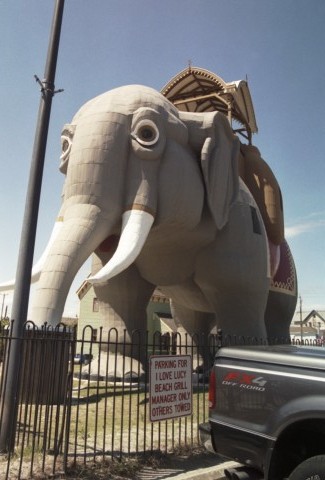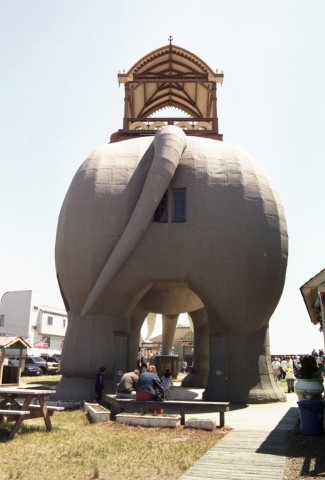
Lucy the Elephant
Margate City, New Jersey

This was the crowning achievement of the Eastern Tour - visiting one of the oldest, most iconic mimetic structures. Built in 1880, Lucy the Elephant is a tin-skinned, wooden frame, 5-story elephant. There were originally three along this seciton of coast, one in Coney Island (home of the last functioning Ten in One, the Mermaid Parade, and Nathan's Famous Hotdogs), one in Cape May, and the last survivor, Lucy.
She was in a sad state at one time in her long history, but the people of the Save Lucy Committee brougnt this proud pachyderm back to its former glorious self. On my visit in late April, there was a steady stream of people venturing up the back leg, through the belly, and down the other leg. The tour guides are fond of saying she's the only elephant you can go through alive, and they were all extremely hospitible and enthusiastic about their amazing attraction.
Sadly, Margate City isn't the loudest supporter of this roadside icon. They're trying to reposition the area as high-end non-mob-related beachfront oasis, with no room for outsized kitschy concoctions that attract the likes of people in traveling roadside attractions. So, the Save Lucy Committee doesn't get the local support they deserve - Please, if you believe in attractions like this, show your support - buy a souvenir, donate a sawbuck or two - keep these amazing things alive: www.lucytheelephant.org.
From the Well Built Elephant: In the late nineteenth century, Atlantic City was a busy resort whose beaches and hotelswere always full up with East Coast vacationers. But Mr. James B. Lafferty, a Philadelphia entrepreneur, had his eye on South Atlantic City, a swampy, sandy wasteland, reachable only by train, coach, or horseback. Mr. Lafferty knew the area was destined for devilopment, and he meant to initiate it by building summer homes. But how to attract potential property owners?
He decided to build an elephant - a huge elephant as tall as a six-story building. Its belly would house an office and restaurant; from the howdah on its back, people could view the beach and the sea and imagine their dream homes.
Lucy was designed by William Free of PHiladelphia and was constructed in 1881 by J. Mason Kirby, at a cost of $38,000. She is 65 feet tall, with legs 20 feet high and 10 feet in diameter. Her body has a circumference of 80 feet; her head is 58 feet around.
Her ears are 17 feet long, her tusks 22 feet, her tail 26 feet. The trunk, which was used as an ash chute, is 36 feet. The basic structure is a timber box frame, to which curved wood pieces have been bolted. The whole thing is sheathed with about 12,000 square feet of tin. Lucy has a 60-foot long domed room in her belly, surrounded by smaller rooms and walk-inclosets in her flanks and jowls. The main room is reached by two spiral staircases in her hind legs. Inside her head is a raised platform like a captain's bridge; her eyes are two large portholes. Staircases in Lucy's flanks lead to the howdah, whose floor is a 16-square foot skylight that illuminates the main room. There are also eighteen windows.
Lucy the Margate Elephant Stats

Built 1881, six stories, wood and tin, see above.
Tours available, hours and whatnot posted at their site:
www.lucytheelephant.org
Tips? Photos? Please share:
World's Largest Things
PO Box 101
Lucas, KS 67648
info@WorldsLargestThings.com
| Home | | Store | | Become a Member | | What's New | | What's Large Where |
copyright and trademark ERNCO Value Added Products and World's Largest Things